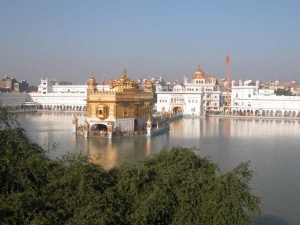The marble slabs at Harmandir Sahib
The Marble Slabs at Harmandir Sahib: A Pakistani Canard by Tarlochan Singh, M.P.*
The Daily ‘AJIT’, in its issue dated January 20, 2008 referred to certain Press Reports, which have given rise to a new controversy, published in various newspapers in Pakistan. The controversial report suggest that the marble used in Harmandir Sahib, Amritsar, during the regime of Maharaja Ranjit Singh was actually removed from the mausoleum of Jahangir, and from others Dargahs, including even the famous Shalimar Bagh of Lahore.
I remember during my visit to Lahore in 1955, when the guide leading the tour to Jahangir’s mausoleum and to Nurjahan’s grave, told us that its precious marble has been stolen! I corrected him on the spot, saying that Sikhs couldn't even think of such a sacrilege. Besides, I pointed out that there were many other marauders who had, from time-to-time, attacked or fought a battle for possession of Lahore. The graves could have been damaged by such assailants.
It is time that Sikh historians probe such frivolous and provocative allegations, using appropriate historical references, to bring the light of truth to this unwarranted controversy, and to put the matter in the correct perspective.
Since I was once the Head of the Museum and Archeological Department, under the Government of India, I have gained good knowledge about the origin and histories of many Heritage buildings, including the Harmandir Sahib. To my knowledge, the present structure of the Darbar Sahib was actually re-built after the attack of Ahmed Shah Abdali in the mid 18th century. Abdali not only destroyed the then existing shrine but filled the holy Sarovar with debris.
When the Sikh Misls regained sovereign power in Punjab, and foreign rulers were thrown out of Punjab, it was only then the reconstruction work of Harmandir Sahib was undertaken. The architects and masons, who did a marvellous job of restoration, were mainly from Rajasthan. The interiors of Harmandir Sahib were artistically painted in Rajasthani style, and there was little use of marble.
In 1801, when Maharaja Ranjit Singh came to power he appointed Sardar Lehna Singh Majithia in-charge of further restoration, to bring it to the gilt exteriors we see today, by gold plating the shrine. The artistic painting on the outer walls of Harmandir Sahib, (now covered with gold plates) were quite visible when, in the recent past, the old gold plates were replaced with new ones by the Nishkam Sewak Jatha. The beautiful historical artistic work of those days can be seen on the upper front side of Darshani Deorhi (unless it has been white-washed in the name of Kar Sewa by the existing managing committee). For many years, I have been appealing to SGPC that the Rajasthani artistic work on Darshani Deori should be reinstalled.
The marble, originally brought from Rajasthan, can only be seen on the side walls of the bridge that connect Darshani Deorhi with Darbar Sahib. Historic records mention that this same marble was once looted on its way to Amritsar. During those days - due to many circumstantial reasons, and old beliefs, Sikhs in general would not use, even touch, anything which had been touched by a 'beef eating' Muslim. How could they have used any marble or stones for their most sacred place that had been removed from graves and Mausoleums? If Maharaja Ranjit Singh could afford to put gold worth lakhs of rupees on the dome and interiors, why could he not afford to have new slabs of marble quarried for the holy Harmandir Sahib? It is also known that Maharaja Ranjit Singh spent generously on the Shahi Masjid, of Lahore (next to the Fort and his own Samadhi) to give it a new look. Tell me how, when the Kotwal of Lahore was a Muslim, could he have allowed any one to remove the marble covering from Jahangir’s Mausoleum or Nurjahan’s grave?
Sikh traditions dictate that anything which has been once used, cannot be re-cycled for use in a sacred place. History provides an excellent example of this, when the Granthi of Darbar Sahib, in 1818, refused to accept a gold-embodied canopy from Maharaha Ranjit Singh (because it had already been used). How could those in charge accept second–hand slabs from the Mauseleum. All the marble, slabs, tiles and other artistic works (including Marble Jallis and Galiyaras - on the bridge - between Darshani Deorhi and Harmandir Sahib) were accomplished by Rajasthani artisans out of the Sikhs' own contributions.
Why such a Myth
The objective behind this misleading myth and canard in Pakistan's Media is apparent: Fanatical elements in Pakistan do not want to see amity and good relationship between Sikhs and Muslims, because they have noticed a distinct improvement in Indo–Pak relations. Now, with the help of Sikh Historians, we should urgently do something to stop and prove this nefarious propaganda, baseless.
The holy Harmandir Sahib has emerged as a universal place of worship for the people of all faiths across the globe, and something needs to be done to curb such malicious reporting. The Daily Ajit which has a good rapport in Pakistan Punjab; should take a lead by disseminating correct information about the Sikh traditions for the benefit of Pakistani scholars.
- article with thanks to sikhreview.org *Translated from original Punjabi, received from the distinguished Parliamentarian.0

